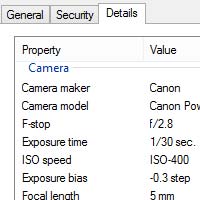| Glossary Of Photography Terms
[12] |
E
Editing Photos Editing photos refers to the process of making adjustments and modifications to digital images to enhance their quality, correct imperfections, and achieve the desired visual aesthetics. Photo editing can include various tasks such as adjusting exposure, color balance, contrast, saturation, sharpness, and cropping. It also involves retouching to remove blemishes, unwanted objects, or distractions, as well as applying creative effects or filters to add artistic flair to the images.
Photo editing can be performed using specialized software applications like Adobe Photoshop, Lightroom, GIMP, or online platforms and mobile apps designed for image manipulation. Editing photos allows photographers and visual artists to refine their compositions, express their creative vision, and produce visually compelling images that resonate with viewers. |
Epoxy resin A clear, viscous coating made from synthetic polymers that is applied to a surface. The resin hardens into a shiny, glass-like coating. Many epoxy resins are self-levelling, which means a flat surface will form without manually spreading the liquid.
Order Online: Epoxy Resin Ex-74
Learn more about our variety of resin coating services.
Read more in our article: Epoxy Resin Coatings |
 |
EV (Exposure Value) Exposure Value (EV) is a numerical scale used in photography to represent combinations of aperture settings, shutter speeds, and ISO sensitivity that result in the same exposure level. It provides a standardized way to quantify exposure settings and facilitate exposure adjustments in different lighting conditions. Each step on the EV scale represents a doubling or halving of the amount of light reaching the camera sensor, resulting in changes to the overall exposure of the image.
For example, increasing the EV by one unit doubles the amount of light, while decreasing it by one unit halves the amount of light. Exposure Value is a useful tool for photographers to maintain consistent exposure levels across different shooting scenarios and make informed decisions when adjusting camera settings. |
EX-74 Resin A liquid coating that, when applied to a flat surface, will harden into a clear, high gloss, protective cover that is resistant to fading and discoloration caused by UV exposure. It is waterproof and heat-resistant once set.
Order Online: Epoxy Resin Ex-74
Read more: Epoxy Resin Coatings |
 |
| EXIF Besides information about the pixels of the image, most cameras store additional information such as the date and time the image was taken, aperture, shutterspeed, ISO, and other camera settings. |
 |
EXIF (Exchangeable Image File Format) EXIF, or Exchangeable Image File Format, is a standard file format used for storing metadata associated with digital images captured by cameras and other imaging devices. EXIF metadata includes information such as camera settings, exposure parameters, date and time of capture, GPS coordinates, and other technical details relevant to the image.
EXIF metadata is embedded within the image file and can be viewed and accessed using image viewing software or metadata readers. It provides valuable information for photographers and image viewers to understand the circumstances and conditions under which the image was captured, as well as to analyze and organize image collections efficiently. |
| Export Exporting in photography refers to the process of saving or converting digital images from one file format to another, typically for sharing, printing, or archiving purposes. When exporting photos, photographers can choose the desired file format, resolution, color profile, and compression settings based on the intended use and requirements of the output medium. Common file formats for exporting photos include JPEG, PNG, TIFF, and PSD (Photoshop Document). Exporting allows photographers to prepare images for distribution on websites, social media platforms, or print publications, ensuring optimal image quality and compatibility with different viewing devices and software applications. |
Exporting Photos Exporting photos refers to the process of saving digital images from a photo editing or management software application to a storage location outside of the program. This typically involves converting the images from their native format, which may be proprietary or specific to the editing software, into a more universal file format such as JPEG, PNG, TIFF, or PSD.
Exporting photos allows photographers to create copies of their edited images for various purposes, including sharing online, printing, archiving, or transferring to other devices. During the export process, photographers can specify parameters such as image quality, resolution, color space, and metadata settings to optimize the exported files for their intended use. |
| Exposure Exposure is the amount of light received by the film or sensor when taking a photo. It is determined by how wide you open the lens diaphragm (aperture) and by how long you keep the film or sensor exposed (shutter speed). |
Exposure Bracketing Exposure bracketing is a photographic technique used to capture multiple images of the same scene at different exposure settings, typically varying the exposure value (EV), aperture, or shutter speed. By taking a series of bracketed shots, photographers can ensure that at least one image in the sequence will have the optimal exposure for the scene.
Exposure bracketing is commonly used in situations where the lighting conditions are challenging or variable, such as high-contrast scenes with bright highlights and deep shadows, or when shooting in rapidly changing light conditions. Bracketed shots can be merged or combined in post-processing to create HDR (High Dynamic Range) images with enhanced detail and tonal range. |
Exposure X Exposure X is a professional photo editing software developed by Alien Skin Software (now Exposure Software). It offers a wide range of editing tools and features for processing and enhancing digital images, including RAW file support, non-destructive editing, advanced color and tone adjustments, customizable presets, and creative effects.
Exposure X is designed to streamline the editing workflow and provide photographers with intuitive tools for achieving their desired results efficiently. It also includes organizational features such as metadata management, keyword tagging, and virtual copies to help photographers organize and manage their image libraries effectively. |
External Hard Drive An external hard drive is a portable storage device that connects to a computer or other digital device via a USB, Thunderbolt, or other interface, providing additional storage space and backup capabilities. External hard drives are used to store digital files, including photos, videos, documents, and software applications, freeing up storage space on the computer's internal hard drive and providing a secure backup solution for important data.
External hard drives come in various capacities, sizes, and configurations, ranging from compact, portable drives suitable for on-the-go use to larger desktop drives designed for high-capacity storage and backup needs. They are essential tools for photographers and other digital content creators who require reliable storage solutions for their growing collections of digital assets. |
|
© 2002-2025 - KeenART Media Ltd.
|
|
| |
|

